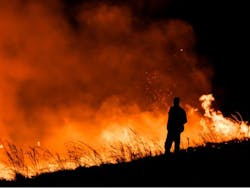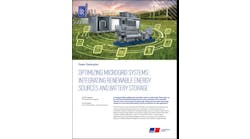Microgrids are getting a boost in California with an eye toward accelerating deployments in advance of the 2020 wildfire season thanks to actions voted on today by the California Public Utilities Commission.
The commission ordered a number of short-term modifications that large investor-owned utilities must implement immediately:
- Accelerate interconnection processes and approvals before upcoming wildfire season, including developing standardized pre-approved system designs for interconnection of resiliency projects; streamlining and improving transparency of processes for inspection and approval and prioritizing interconnection of resiliency projects for critical facilities and customers
- Adopt tariff changes to maximize social resiliency benefits, and modify net energy metering rules to remove energy storage sizing limits
- Better collaborate and communicate with local and tribal governments, conduct meetings to educate and inform them about critical operations, develop a resiliency project guide, create dedicated staff to service these agencies, and assist them with navigating the notoriously roundabout utility interconnection process
Along with these changes, the commission also approved a wide-ranging set of resiliency proposals specifically from Pacific Gas & Electric and San Diego Gas & Electric. (See related article.)
Disaster preparedness
While the upcoming wildfire season — which typically starts around September 1 — is driving a renewed sense of urgency, the commission’s decision is one of the outcomes of CA SB 1399 which was signed into law in 2018.
SB 1339 requires the commission, in consultation with the California Energy Commission and the California Independent System Operator, take specific actions to facilitate the commercialization and deployment of microgrids. These actions include new standards and guidelines, simplified protocols, and, where necessary, changes to rates and tariffs for how microgrids and resilient assets are compensated.
The law was designed to both accelerate the industry and expand the societal benefits of resilient infrastructure. In disaster-prone California, earthquakes, mudslides, and especially wildfires are season-to-season realities for the state’s nearly 40 million residents.
In response to increasingly deadly and costly wildfires, last summer California’s three major investor-owned utilities implemented a new process called ‘public-safety power shutoffs’, where utilities periodically turned off customers’ power in advance of high-risk wildfire days to reduce the chance of utility equipment igniting a blaze. It is estimated that equipment owned by the utilities caused more than 2,000 wildfires from June 2014 through 2017.
In 2018, the ‘Camp Fire’ destroyed nearly 95% of the town of Paradise and decimated surrounding areas. State officials later determined that the fire was ignited by faulty transmission equipment owned by PG&E. It was the deadliest wildfire in California’s history, and the nearly $16.5 billion in insured losses made it the most expensive natural disaster in the world that year.
In response to these disasters, in 2019 utilities across the state shut off power to more than three million customers at different points in October and November. The widespread blackouts were implemented quickly and widely criticized as poorly communicated and somewhat chaotic.
By Fsmelo/Shutterstock.com
And while utility decisions to shut down power were very deliberate and informed by weather and wind modeling, the resulting outages did not discriminate, leaving local governments, emergency responders, and other critical infrastructure without grid power.
Customers often had little notice — receiving only a pre-recorded call telling them when power would be turned off without saying when it would be turned back on. During public comments at the CPUC meeting, many who called in to the virtual meeting shared their concerns about power shutoffs and their impacts on vulnerable communities across the state. One commenter reported five days of lost power preceded by only a few hours notice that the shutoff was about to begin.
Microgrids as resilience solutions
Microgrids — which can enable a building, or an entire community, to ‘island’ itself from the grid — are a long-term solution to address the need for resilience. In the case of a power shutoff, a microgrid system can respond immediately and keep the lights, appliances, and any critical equipment operational for extended periods of time.
Today’s order by the California commission seeks to address many of the current challenges and barriers that lead to long delays for microgrids to interconnect to the grid, and tariff structures that discourage resilient infrastructure.
Even though wildfire season typically does not start for a few months, there are already a number of fires active across the state, particularly in and around Southern California Edison’s territory due to dry and windy conditions.
To encourage more microgrids and help ensure they can be deployed rapidly, the public utilities commission ordered utilities to create an easily replicable standard for microgrids so that developers and customers can quickly determine if their system will be able to plug into the grid without hurdles in the interconnection process.
Interconnection queues and their bureaucratic complexities are often cited by developers as a significant hurdle in most markets for microgrids, energy storage, and other on-site generation technologies.
Additionally, the tariff, rate, and net metering changes could enhance the ability to provide societal resilience benefits by enabling more microgrids. As an example, if a microgrid operator at a long-term care facility received a call from their utility indicating an imminent shutoff, they could top up their batteries and stop providing other grid services to prepare for an extended outage. But current rules make this difficult. The microgrid operator might be penalized financially — subject to time-of-use rates, demand response penalties, or other unfavorable conditions that could discourage resilience solutions.
All resilience is local
By ESB Professional/Shutterstock.com
The order also specifically directs the utilities to more effectively collaborate and communicate with local and tribal governments regarding disaster-readiness strategies and the potential for microgrids to enable local resilience. When power shutoffs were imposed in 2019, the short notice left many local jurisdictions and tribal communities ill prepared for extended outages. Sometimes left without critical equipment and infrastructure, emergency services and other public safety operations were significantly impacted — the opposite of the intent for ‘public-safety’ shutoffs.
Furthermore, this decision directs the large investor-owned utilities to dedicate staff to manage the intake of local and tribal government resiliency projects; as well as create a separate, access-restricted data portal for local and tribal governments to review data essential for microgrid and resiliency project development.
Access to this data and information could significantly benefit local authorities seeking to deploy resilient energy infrastructure, and be a boon for developer partners to help accelerate the project development timeline.
Public utilities commission okays temporary diesel
While the multiple changes to resilience strategies and microgrid deployment ordered by the commission were widely hailed as necessary and prudent, one point of contention that spurred a lot of comments from the clean energy community is the inclusion of fossil fuel generators. However, in the face of the immediate threat posed by wildfires, the commission upheld the utility plan to use the portable fossil fuel generators because they can be quickly deployed and are well-tested and cost-effective in the field. The Diesel Technology Forum celebrated the order, arguing that the reliability and resilience benefits of diesel generators outweighed any additional emissions from powering a microgrid with them during infrequent periods of outage.
The commission gave PG&E permission to spend about $320 million this year on resilience programs, including a “temporary generation” program that calls for having up to 300 MW of mobile generation that can be used to create temporary microgrids. For the 2020 wildfire season, PG&E plans to fill that need by leasing diesel generators at an estimated cost of $94 million. Today’s vote approves that request with the caveat that the utility only uses the diesel generators for one year.
The public utilities commission decision (R.19-09-009) is available here.
Matt Roberts is the director of strategic growth & government affairs at Microgrid Knowledge.







